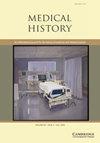通过疫苗接种动员:法国脊髓灰质炎病例(1950 - 60年代)
IF 0.9
2区 哲学
Q4 HEALTH CARE SCIENCES & SERVICES
引用次数: 0
摘要
脊髓灰质炎是一种发病率在20世纪下半叶在大西洋两岸稳步上升的疾病。如果在美国,每年夏天折磨幼儿的流行病成为一个主要的公共卫生问题,在法国,小儿麻痹症被认为没有其他疾病那么紧迫。本文以巴斯德研究所和姆萨梅研究所的原始档案为基础,分析了法国从20世纪50年代中期到60年代末实施的脊髓灰质炎控制战略和政策。本文考察了动员法国卫生当局防治该疾病的两个关键行为者和机构的作用:皮埃尔·莱姆萨伊和巴斯德研究所,以及查尔斯·姆萨伊和姆萨伊研究所。lsampine开发了一种有效的脊髓灰质炎注射疫苗,在补充口服脊髓灰质炎疫苗之前,首先使用了这种疫苗。如果两个主要参与者及其机构共同努力,他们各自在不同的时间实施不同的行动和策略,目的是提高对防治这种疾病的认识。法国主要行为体的国内和国际关系对小儿麻痹症疫苗的研制和生产及其应用起着决定性作用。这项工作有助于了解国家机构一级小儿麻痹症疫苗选择的过程,并分析为支持小儿麻痹症疫苗接种而建立的政治和科学网络,以最终实现强制疫苗接种。最后,本研究描述了这种疾病在法国与集体保护的生物技术合并的历史过程。本文章由计算机程序翻译,如有差异,请以英文原文为准。
Mobilising through vaccination: the case of polio in France (1950–60s)
Abstract Poliomyelitis is a disease whose incidence steadily increased during the second half of the twentieth century on both sides of the Atlantic. If in the United States the epidemics which afflicted young children each summer became a major public health issue, in France, polio was considered less pressing than other diseases. This article, based on original archives from the Pasteur and Mérieux institutes, analyses the polio control strategies and policies implemented by France from the mid-1950s to the end of the 1960s. The article examines the role of two key actors and institutions that mobilised the French health authorities against the disease: Pierre Lépine and the Institut Pasteur as well as Charles Mérieux and the Institut Mérieux. Lépine developed an effective injected polio vaccine which was first used before being supplemented with the oral polio vaccine. If the two main protagonists and their institutions worked together, they each implemented different actions and manoeuvres, at different times with the aim to raise awareness of the fight against the disease. The national and international relations of the key French actors were decisive in the development and production of the polio vaccines and their application. This work contributes to understanding processes of polio vaccines choice at the level of national institutions and analyses the political and scientific networks built in support of polio vaccination, to finally move towards compulsory vaccination. Ultimately, this study describes the historical processes by which this disease became conflated with a biotechnology of collective protection in France.
求助全文
通过发布文献求助,成功后即可免费获取论文全文。
去求助
来源期刊

Medical History
医学-科学史与科学哲学
CiteScore
1.60
自引率
0.00%
发文量
25
审稿时长
>12 weeks
期刊介绍:
Medical History is a refereed journal devoted to all aspects of the history of medicine and health, with the goal of broadening and deepening the understanding of the field, in the widest sense, by historical studies of the highest quality. It is also the journal of the European Association for the History of Medicine and Health. The membership of the Editorial Board, which includes senior members of the EAHMH, reflects the commitment to the finest international standards in refereeing of submitted papers and the reviewing of books. The journal publishes in English, but welcomes submissions from scholars for whom English is not a first language; language and copy-editing assistance will be provided wherever possible.
 求助内容:
求助内容: 应助结果提醒方式:
应助结果提醒方式:


